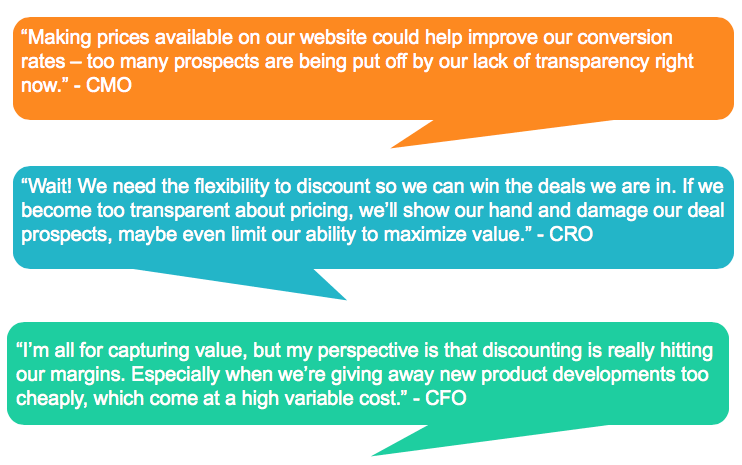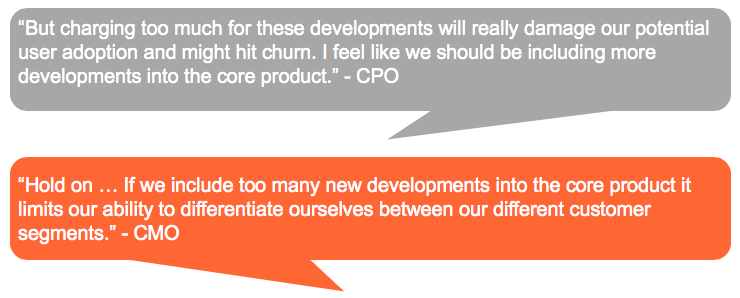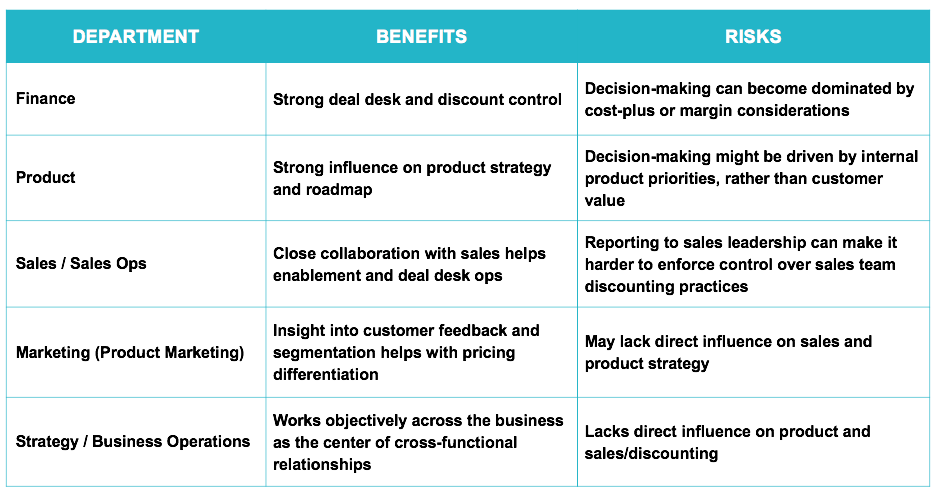Where Should Pricing Decision-Making Live Within an Organization?

ScaleUp companies universally need to tackle pricing and packaging questions during their journey from $10M ARR to $100M ARR and beyond. Companies on this journey frequently ask us, “Who should own pricing within my organization?” and “Do I need dedicated resource?”
These questions are understandably complex, and the answer on how to build a pricing function is not one-size-fits-all. Pricing and packaging decisions require collaboration across the entire organization. Within the executive team alone, key stakeholders in pricing can have very different goals.
Consider the following hypothetical exchange:


So many conflicting opinions makes it hard to build a department that must operate cross-functionally. In this article, we will explore how despite these challenges you can set up your pricing organization for success.
Deciding where pricing reports
Pricing is so cross-functional that it can live almost anywhere. We have seen pricing organizations within finance, product, sales, marketing, and business operations. Each have some advantages and disadvantages, due to the proximity to sources of data and areas of influence:

There really is no "right" answer, as every company will differ in environment and needs. However, pricing by committee is not a tenable option for scaling businesses — above $50m in ARR we recommend a dedicated pricing resource somewhere in the organization.
In our experience, some of the most successful pricing programs have lived within product or product marketing. This is because it gives the pricing department greater influence on one of the most important levers: packaging strategy. Alternatively, a strong strategy / business operations / office of the CEO unit may be a great home thanks to its ability to work cross-functionally across the organization.
Regardless of where the pricing function lives, following these best practices will lead to success:
- Impartiality is essential: Given how views on pricing strategy can differ, the pricing team should be able to make decisions without being influenced too much towards any one direction. Facts and data should be the foundation for strategy.
- Pricing belongs at the top: The final say on pricing strategy should live at the executive team level. This is the only way to ensure a successful roll-out, with all key stakeholders part of the discussion.
- High-performing organizations keep the CEO involved: The CEO should be involved, as he or she can act as the tie-breaker in many of these decisions being made across departments, and drive pricing excellence.
- Data is essential: Pricing decision-making needs to be made on objective fact, and that means pricing data. Your team should be watching the metrics that track pricing activity, improvement opportunities, and ongoing performance.
What skills does the pricing team need?
How much resource you need to dedicate to pricing will depend on the size of your firm and the number of pricing responsibilities that are shared across other departments. However, there is a consistent skillset required of the role:
- Strategic thinking: Pricing is an important part of the overall revenue strategy of the company. Pricing decisions and recommendations need to be strategically sound and in line with core objectives.
- Presentation and influence: The pricing team needs to enable decision making at the executive team level. They must be able to make compelling arguments based on analysis to help drive pricing processes and generate C-level buy-in.
- Analytics expertise: The pricing team should be skilled in data analysis (e.g. transaction, customer and usage data) to develop the right fact base. Finding patterns and objective insights to support decision-making is vital.
- Customer research: Leveraging customer research is critical for both gathering data and validating the decision making before launch. The team should have experience running research projects and be familiar with quantitative and qualitative pricing research techniques.
- Cross-functional collaboration: With many touchpoints across the organization, the pricing team needs to be able to cultivate relationships and work across teams from sales to product management.
Summary
Because of how cross functional it is, a pricing organization can be successful wherever it lives in the organization, and we often see product or business operations as a natural fit. We recommend a dedicated owner of pricing as your company scales above $50m ARR. In any part of the organization, you can set your pricing function up for success by:
- Ensuring it can be influential at the executive level
- Keeping it objective and protected from departmental influence
- Providing it access to the right data and materials
- Hiring or developing people with the right skills to make strategic pricing decisions
Still Looking for More?
Have more questions around setting up your pricing for success? Onsite is here to guide you via our experience and pattern recognition. We can be reached at pricingoncall@insightpartners.com. You can also read our article, Pricing for Growth: Top To-Do's as Companies ScaleUp, to learn more best practices.
READ NOW








